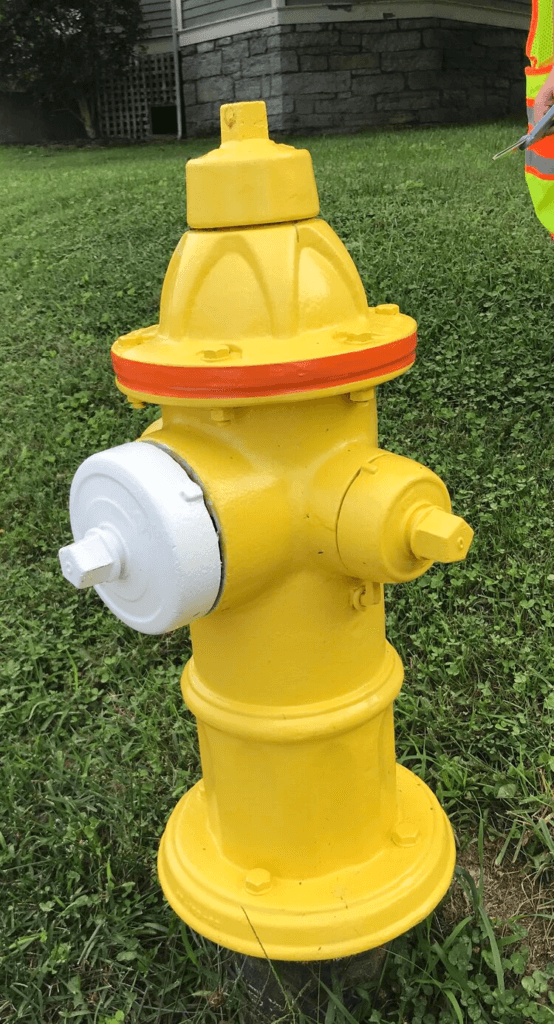By: Assistant Chief Michael Fronimos
Wytheville Fire & Rescue Department
Developing a hydrant management program makes the difference between uncertainty and informed response when it comes to water supply. Whether you want to improve your pre-fire plans, troubleshoot the water supply in your district, or lower your ISO score, hydrant management makes sense.

By developing an effective and sustainable program, you will keep your community safer and help lower insurance rates for your citizens. Plus, you will build a better relationship with your public works department as you understand and help maintain your city’s water supply.
It also gives you and your personnel the opportunity to positively interact with the citizens in a non-emergency situation. When conducting flow testing or painting of hydrants, what better way to engage the customers than by allowing a small child and parent to watch or participate? That small interaction may plant a seed for a future firefighter, and at minimum it gives the parents a chance to brag about “their fire department” on social media to their friends and family. A win-win situation, even if it costs an extra five minutes at a hydrant. Remember, we work for them.
One thing I learned years ago as a young firefighter, and have my firefighters do today, is make contact with each fire hydrant at least three times each year.
Now, depending what type of painting schedule you develop (every year, every two years, it all depends upon AHJ) and weed-eating of hydrants, it could be more or less than three times a year.
If your department needs to develop a hydrant management program, here are some practical guidelines for how to start one from scratch.
First, locate all of your water sources. Your community may already have a hydrant file listing locations for all the fire hydrants in your district. Ask your water department or commissioner for this information, then make sure you go out in the field and check it for accuracy. If no hydrant file exists, it’s very easy to start your own.
Next, get out in your community and drive up and down the streets looking for hydrants. Again, if the opportunity presents itself stop, and engage with your community. Explain to them what you are doing and why. Educate your customers, garner their support and explain the technology that you are using and the importance of using apps such as FlowMSP.
When you find a hydrant, use a GPS tagging device to pinpoint the hydrant latitude and longitude. We used the FlowMSP app for this, and we also added the hydrants into the FlowMSP app as we found each one. Now our app shows hydrant locations for every hydrant in our community, plus we added several in the surrounding county where we respond frequently.
An added bonus: When our crews drove to locate and pin hydrants, they learned streets, various construction features and identifying other potential hazards or limitations in their first due response area. The learning potential was limitless, making every day a training day. I have even utilized the FlowMSP app for classroom training in pre-plans and area familiarization.
Once you identify your hydrants, you can begin your flow testing. Our department followed NFPA guidelines as we drafted a policy and guidelines for fixed water supplies and hydrant testing. Then, we created a spreadsheet where we could input:
We used the HoseMaster Hydrant Testing Kit to easily calculate accurate required flow and gallons per minute

Another critical step in developing a hydrant management program is packaging the information so your first-in responders can easily use it during an incident. Our department uses the FlowMSP app for this. The data we collected lives in our app, and we can quickly pull it up by tapping a dispatch notification.
If you have FlowMSP, once you finish flow testing and recording the hydrant data, upload your hydrant file into your FlowMSP app. This populates the app with all the information you just collected. Then, the required flow rate and GPM will show up when you tap a dispatch notification, and the best hydrants for the incident location will be highlighted for you.
A member of the FlowMSP team can walk you through a demonstration of the FlowMSP app and show you how this tool will work in your jurisdiction.
As you develop your hydrant management program, consider hydrant visibility and accessibility. If you notice hydrants in your district that are blocked or not easily visible, take steps to ensure first responders can easily see and access the water sources.
If a hydrant is blocked by bushes or other obstructions, draft a letter to the home or business owner kindly asking them to clear the area about 36” around the hydrant. Many people prefer to do it themselves rather than have someone cut their bushes. Plus, this will save your department some time and labor.
With your hydrants clear, you can move on to painting. To prep a hydrant which hadn’t been painted in many years, we spent a lot of time cleaning the hydrants of old paint, flaked paint, rust and grime. This was labor intensive, but it also caused something else to happen: friendly rivalry amongst shifts.

Our department chose to paint our hydrants yellow for easy visibility at night, and we painted any odd-sized caps white.
For example, most of our hydrants have a standard 2” or 5” cap, but some of them have 4 ½” caps.
Painting the odd-sized caps saves time by helping our firefighters recognize the size at a glance.
The tape around the bonnet is reflective for easy visibility at night, and it is color-coded according to the NFPA color code for flow rating.
Painting hydrants helped build a sense of pride and ownership in our hydrants, which led to other aspects of the job too…and our community saw it! There’s nothing better for a fire chief than driving through your community seeing brightly painted fire hydrants on a nice green lawn, followed by an engine crew stopped with a mother and kids, and the kids getting to put a few slaps of paint on a fire hydrant. It’s now THEIR fire hydrant.
We chose to tape our hydrants with reflective tape that matches the NFPA color code for flow rating. This makes flow rate identification easy by day or night. Our department placed the tape just under the bonnet where it bolts to the barrel of each fire hydrant. Some hydrants we had to adjust or modify depending on its shape, but every hydrant has been identified.
Now that you know the basic features of a good hydrant management plan, here is the first step to execute on it: develop your own plan for what you want to accomplish, which steps to take, and when. The steps in this article will help you build the framework for this plan, and you can modify them to suit your department’s needs. But make sure you have a good plan before you start doing the work, and make sure you contact all the stakeholders (commissioners, council, mayor, public works, etc).
Buy-in from your crews is key, as you will hear grumbling about it. As we say in the fire service, “Two things firefighters hate: the way things are and change,” but this ultimately has several advantages that can pay huge dividends for the organization, the personnel and the community.
Implementation of your hydrant management plan may raise a few eyebrows as you send firefighters out to do the work. To prepare for this, run a public relations campaign on social media ahead of time. Tell your community what you plan to do so they will not be surprised when firefighters show up in their neighborhoods.
Our community was overwhelmingly supportive of our projects because we told them what to expect, and we explained how painting and taping the hydrants would help keep them safe. We also made sure they knew that this work would help lower their insurance rates.
Once you determine which tasks to do and when, break your city into hydrant districts based on GPS locations. Then, assign the districts to your department’s different shifts. Build the tasks into each shift’s workflow according to the timeline you set for task completion. This keeps everyone moving forward on the project.
As your crew begins checking hydrants, they may find some very old or out-of-service hydrants. Take notes and pictures of these issues and submit them to your water department or water commissioner so they can repair or replace them. You can help troubleshoot and improve your city’s water supply.
Developing a hydrant management program is neither very easy nor very hard, and most departments will find themselves up to the task. Now that you know the steps to take, go start your own hydrant management program. Your department and your community will reap the rewards of a well-managed water supply as you respond to incidents quickly and with better information.
In this recorded webinar Assistant Chief Michael Fronimos of Wytheville Fire Department describes how his department manages hydrant data. He uses the FlowMSP platform to collect and organize water source information so firefighters can quickly and easily access it when responding to an incident.
The author invites you to reach out with questions about how to develop your own hydrant management program.

Michael F. Fronimos
Assistant Chief (Retired)
Public Information Officer
Email: nkyfirepio1@yahoo.com
Personal Cell: (859) 393-4317
Facebook: @Mike Fronimos (Michael A. Fronimos)
“The best executive is the one who has sense enough to pick good men to do what he wants done, and self-restraint enough to keep from meddling with them while they do it.” —Theodore Roosevelt
A member of the FlowMSP team can walk you through a personal online demonstration of the FlowMSP app. In this one-on-one experience you can outline your department’s goals and see how FlowMSP can help.
Prefer to explore the FlowMSP app on your own? You can try us out for free and reach out to our team if you want more information. We will send you several emails with how-to videos, answers to frequently asked questions, and an invitation to a web demo. You can decide how much interaction you want with our team.